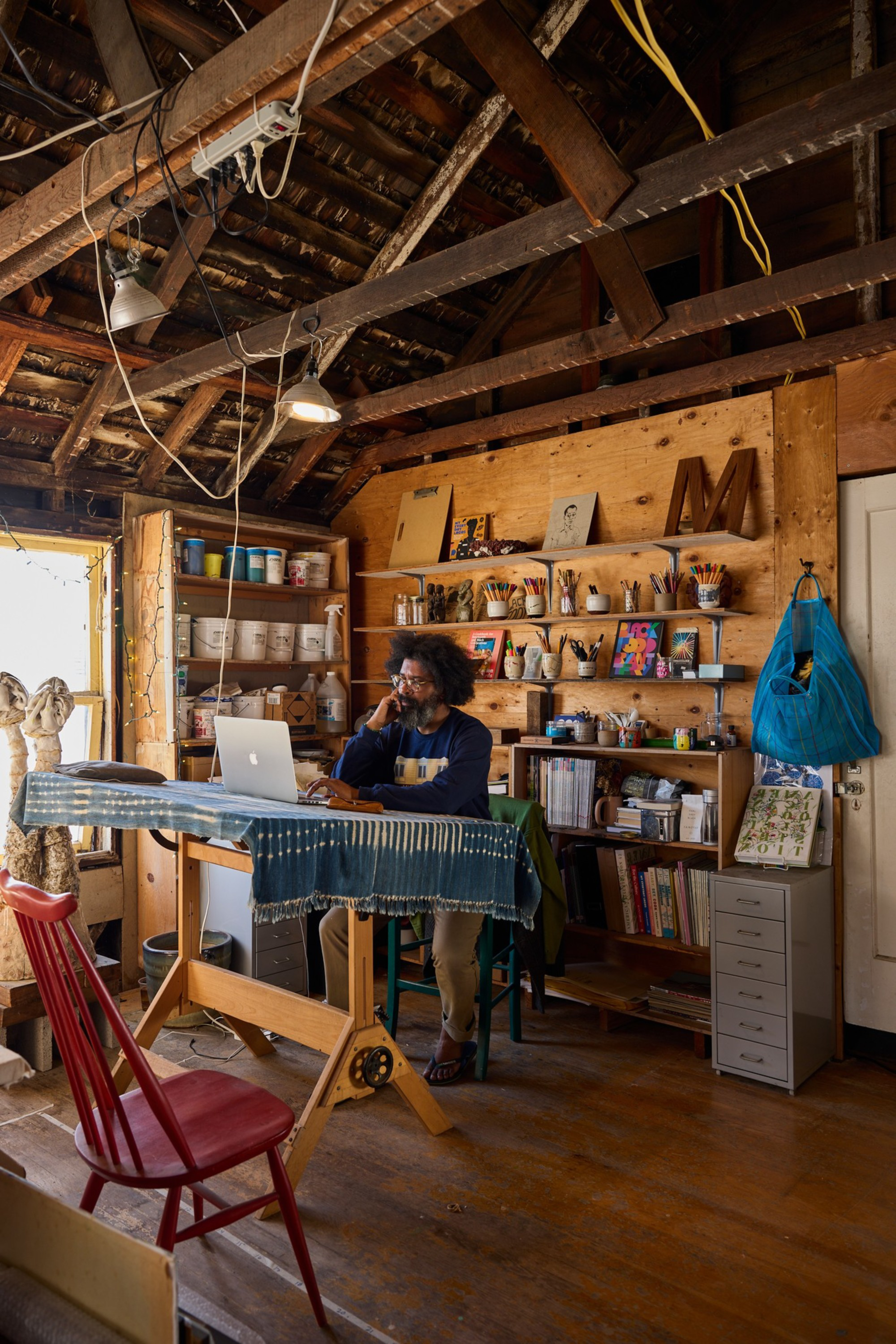The prodigious graphic designer, artist, and author George McCalman believes time is not linear — that the past exists right beside us, intertwined with the present. Which is why he is drawn to buildings that wear the batterings and bruises of their history like badges of honor.
As McCalman prepares for the Nov. 22 launch of his interactive exhibition “A March Through Time” (opens in new tab) at Pier 29, he offered a tour of the timeworn spaces that are incubating his largest and most ambitious projects: his studio and the cavernous pier itself.
For nine years, McCalman has worked out of the top floor of an Outer Sunset home. Even in the fog- and salt-blasted neighborhood, where rust and battered gray wood are the norm, this three-story structure rises like an ancient ship next to its petite and freshly painted neighbors.




“What I love about this space is how the creative process is exposed,” says McCalman, whose design firm McCalman and Co. (opens in new tab) is engaged in dozens of projects. He is responsible for the exhibition design for the current show at the Museum of the African Diaspora, “Unbound”; he designed the interiors and branding for Nopa Fish in the Ferry Building; and he’s working on a pair of exhibition designs for the Manetti Shrem Museum of Art. His unusual studio is where it all happens.
Decades-old plywood sheets cover the facade in a “Tetris”-like configuration of various shapes and sizes. A bay window protrudes from the second story, wrapped in aged, horizontal, redwood planks patinated to a near black. The entry stair is made of rough-textured concrete that resembles a smoke-streaked cave wall. The thin, shaggy-shingled roof looks as if a strong wind could lift it from the house like so much cardboard. Just inside, past the threshold, a hearty ivy climbs the interior wall through a sizable hole in the floor.



The studio is owned by an artisan couple, architect Douglas Jacuzzi (opens in new tab) and ceramicist Georgia Hodges (opens in new tab), who live in the building directly behind this one. They view both structures as philosophical expressions of their belief in the purity of materials and the reverence of process. Not surprisingly, the couple are devotees of the late artist David Ireland, whose own stripped-down home at 500 Capp St. (opens in new tab) has been preserved as “living sculpture” and a center for experimental new artists.


The interior of the art studio has the feel of a long-abandoned construction site. Redwood framing is visible throughout, and brightly colored extension cords are strung across the rafters like holiday bunting. A fireplace surrounded by ivory-painted brick seems to float like a ghost against the dark wood beams. McCalman shares the studio with Hodges, so hefty bags of clay sit near an ancient Singer sewing machine, which fights for space on a desk with colored pencils and jugs of paint.
McCalman can usually be found at his drafting table, sketching or doing computer work, or at his large work bench, where his more sizable paintings come to life. It was in this space that he created the 155 portraits of Black pioneers that make up his book “Illustrated Black History.”
And it was here that he conceived “A March Through Time,” an expansion on the book and an amuse-bouche to a much larger exhibition of the same name opening in the spring. To execute the vision, he needed someplace bigger. Much bigger.

Pier 29 on the sunny Embarcadero feels worlds away from the creaky Edwardian by the beach. The classical bulkhead building features a gabled parapet and monumental arches. From the outside, it looks good for its age. But inside, the 110-year-old structure is timestamped with decay. Aging timber trusses support a roof pocked with punctures, as evidenced by the puddles darkening the concrete floors; the shattered windowpanes are likely another culprit. Yellow “caution” tape sections off chunks of the space for mysterious reasons.
But the center of the 150,000-square-foot space glows like a coral-colored lightbox. McCalman has hung from the trusses flowing, sheer fabric the color of cantaloupe flesh, demarcating a 5,000-square-foot gallery. Within it are hung 15 of his portraits, printed on thin sheets of silky fabric. These are just one element of the multi-sensory show. Musicians, dancers, poets, and other artists will play roles in the 90-minute experience. Timed showings will be limited to 100 people at a time.

“I wanted people to be able to see the background, meaning the building itself,” says McCalman, who worked closely with Miriam Thompson, his partner in McCalman and Co., to design the space. “I wanted something that was ethereal, that you could see through and view from both sides. We wanted to express this alternative concept of time, of seeing through time, and of bringing Black accomplishments closer to us. We’re inviting people to experience our history in a different way.”
This is the first artistic activation of Pier 29, also the home of Art + Water, a new nonprofit led by writer Dave Eggers and artist and filmmaker J.D. Beltran. McCalman was invited by the arts-focused landlord, Cast, to take over a portion of the long-empty space, but once he and Eggers met, they began collaborating.
Once this iteration of the exhibition closes, McCalman will continue to utilize Pier 29 as additional studio space, where he plans to create a new body of work for the spring exhibition, which will take over a much larger space within Pier 29. McCalman is tight-lipped about what to expect, except that it will be a dramatic deviation from the portraiture he’s known for.
“As an artist, I’m continually pigeonholed, and every couple of years I redefine how I’m working, and I hear every time, ‘Oh, I didn’t know you could do that!’” he says. “And I love that. I love that I’m still underestimated. I love it.”
